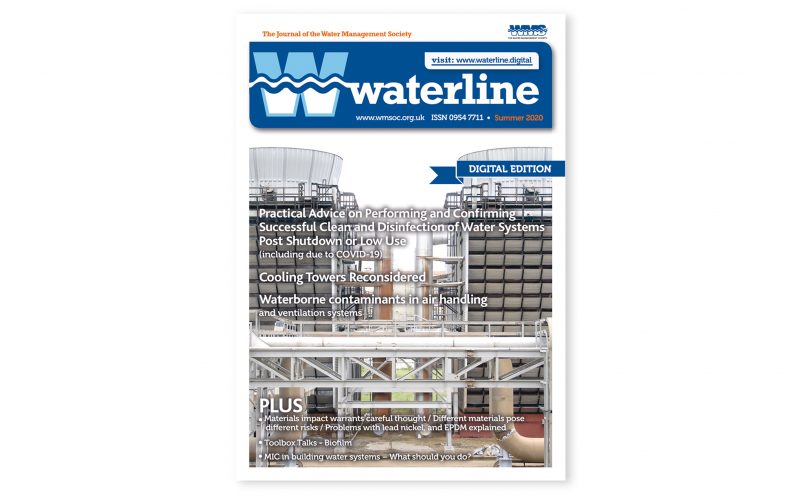The article first appeared in the November 2019 edition of Health Estate Journal (www.healthestatejournal.com), the IHEEM (www.iheem.org.uk) magazine.
As featured in waterline Summer 2020

Materials impact warrants careful thought / Different materials pose different risks / Problems with lead nickel, and EPDM explained
Paul Millard, WRAS
Paul Millard, Technical Manager at the Water Regulations Advisory Scheme (WRAS), highlights three key plumbing material issues which he says should be considered and addressed within Water Safety Plans (WSP) to maintain the water supply in hospitals and other healthcare facilities in a safe and hygienic condition.
The development, construction, installation, commissioning and maintenance of hot and coldwater supply systems is vital for public health. Healthcare premises are dependent upon water to maintain hygiene and a comfortable environment for patients and staff and for treatment and diagnostic purposes. The safe use of water is an important issue, where potential contamination could have a greater impact on vulnerable people. Patients are more likely to have weakened immune systems, putting them at a particular disadvantage when exposed to any contamination of the water supply. The Department of Health & Social Care has long recognised the importance of safe water in healthcare premises and provides key guidance through its Health Technical Memorandum, HTM 04-01. One of the recommendations is the establishment of a WSG – a multidisciplinary group, one of whose key responsibilities is to undertake the commissioning and management of Water Safety Plans (WSPs).
Three key issues
In this article, I intend to highlight three key material-related issues which should be considered and addressed within WSPs. Use of appropriate materials is one important preventive measure and I will consider potential problems related to lead, nickel and EPDM rubber and how to avoid them within healthcare premises. WRAS was set up by UK water companies to assist individuals and organisations in complying with water fittings regulations. The regulations are in place to ensure that the water supply to public and private premises, including healthcare buildings, is safe.
Lead
Lead is a highly toxic metal that is known to affect the brain and parts of the nervous system when ingested. Commonly used in plumbing systems until 1970, it can still be found today in the pipes or fittings of old buildings with historic water systems that haven’t been updated. The World Health Organization (WHO) makes it clear that there is no known level of lead exposure that is considered safe. If lead is kept in contact with water for an extended period, it can permeate the Materials impact warrants careful thought / Different materials pose different risks / Problems with lead nickel, and EPDM explained drinking water supply and be harmful to those who ingest it. The lead from the pipes or fittings can dissolve into the water and this possibility is increased throughout the length of time the water remains stationary within the fittings. So, if a tap has not been opened for a while, the lead in the pipes carrying the water supply may dissolve into the supply, contaminating the water and making it unsuitable for consumption.
Restrictions not retrospective
Although it has been illegal to use lead pipes and lead solder on wholesome drinking water systems for over 30 years, these restrictions are not retrospective, so do not legally require older systems to be updated. The limits for lead exposure in drinking water are currently under review in the UK and EU, meaning that there is the potential for limits to be further reduced, decreasing the chance of harmful contamination of wholesome water systems. The lead particles in contaminated water cannot be completely removed after they enter the human body and consequently, the concentration of lead builds up within the body over time. Research into the effects of lead highlight that the young and old are particularly at risk; the effects of exposure range from joint and muscle pain to memory loss and the lowering of IQ levels, which is particularly important when the patients in a healthcare facility are taken into consideration. The elderly are more likely to have weaker joints, making them more susceptible to further damage, and demographics such as children, infants, and the unborn babies of pregnant women, are at risk of cognitive development issues if exposed to lead. This is not a short-term problem, as cognitive development at early stages of life is directly linked to IQ, which can be linked to adult factors such as earning potential in later life.
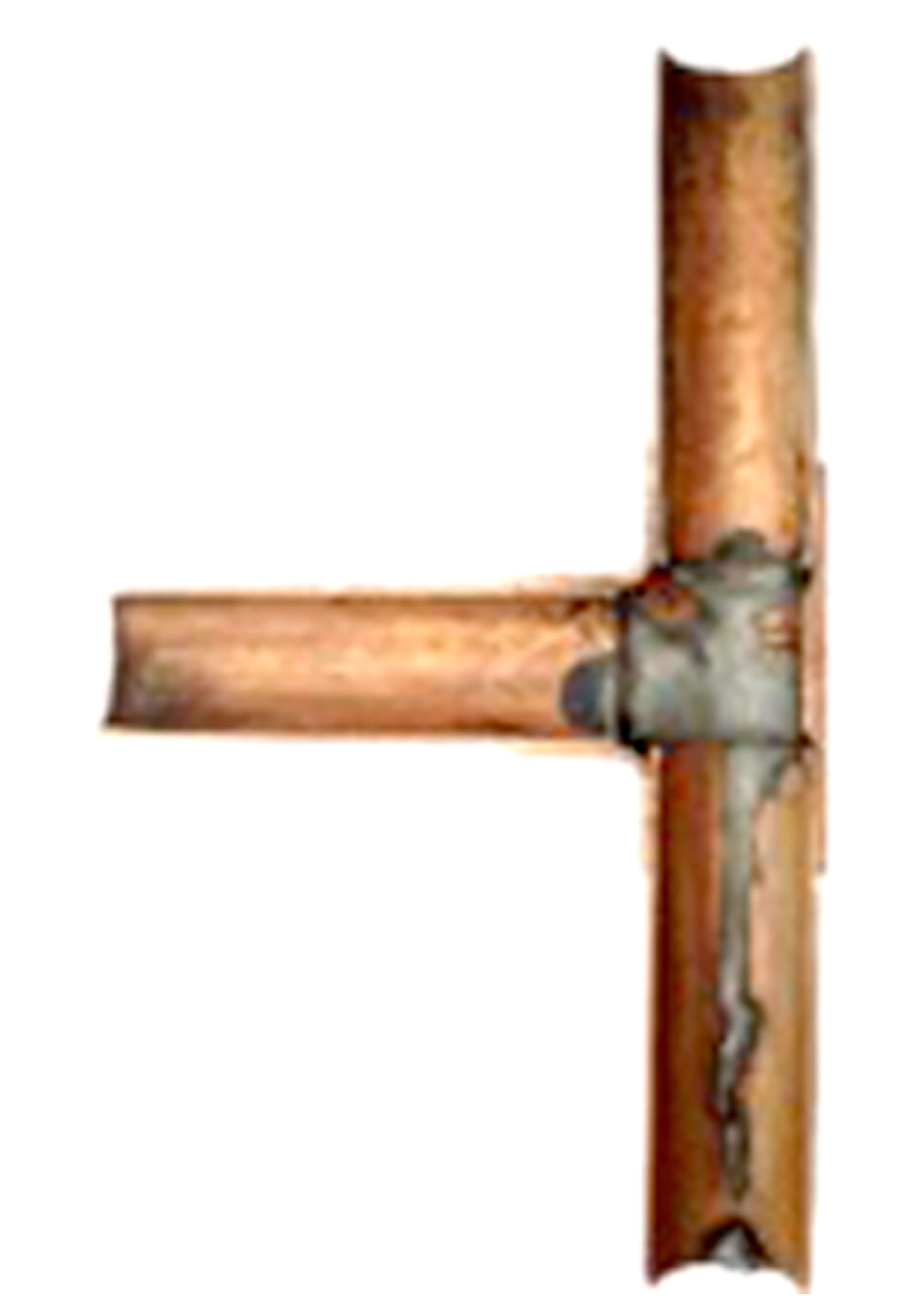
Poorly soldered joint increases the contact area of lead with the water supply.
Adequate backflow
The use of lead on any part of a wholesome water system is prohibited by the Water Supply (Water Fittings) Regulations and Scottish Byelaws. This includes lead pipes, solder, or any other fitting and encompasses any water system that is directly used for, or has the potential to interact with, drinking water. While lead is allowed on closed circuit heating and gas systems, these systems are legally required to be fitted with adequate backflow protection to ensure that they do not contaminate the drinking water supply. Some contractors will choose to use lead solder on these permitted systems, as it is cheaper and easier to work with than its lead-free counterpart, but the two are virtually indistinguishable by sight and easy to confuse – a dangerous mistake if made on potable water systems. For this reason, it is recommended that contractors do not use lead on any system and simply remove it from their toolbox to avoid confusion and potential contamination.
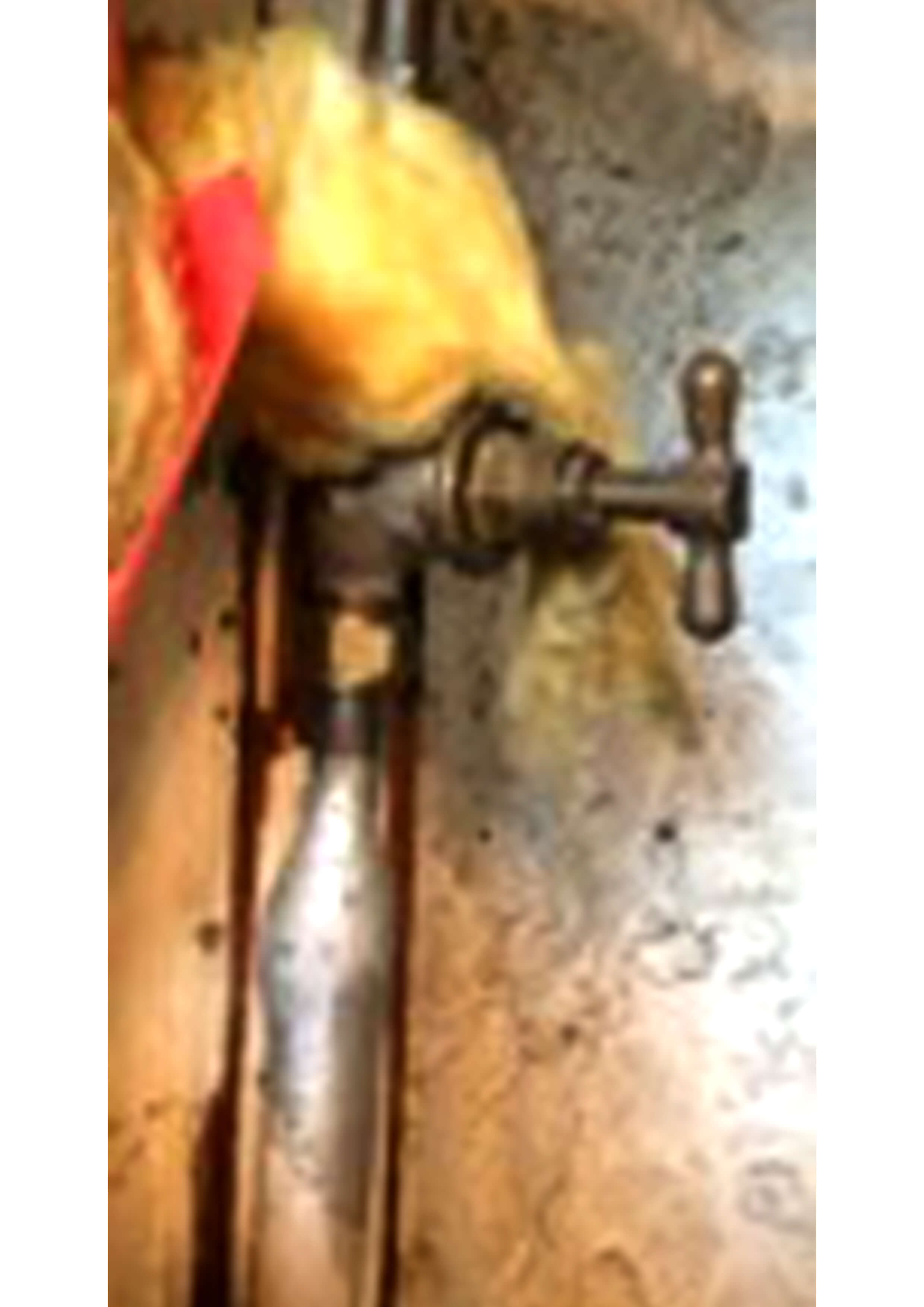
A lead stop-tap.
Built before 1970?
In areas with a particularly high proportion of vulnerable people, such as a hospital or other healthcare estate, it’s worth checking for lead pipes if the building was erected before 1970. WaterSafe has created a useful video to show the easiest way of testing – a scratch test – which can be found at watersafe.org.uk/lead. Unpainted lead pipes are soft and dull grey in colour but will reveal a shiny silver metal when the surface is gently scraped with a coin. This is the most straightforward way of testing for lead pipes, but it’s vital that anybody completing this scratch test washes their hands thoroughly after working with the lead to avoid ingestion of the metal. The possibility of lead in your plumbing doesn’t just lie in the pipes themselves, however, and it is just as important to make sure that your water systems don’t make use of lead solder. There are test kits available to purchase to check for this and these are being used to detect unauthorised use of lead solder by facility managers, owners, and water company enforcers alike. It is illegal for the general public to buy lead products, but the illegitimate use of lead solder is still an issue within the industry, as it is available to purchase for ‘professional users’. Examples of legal prosecution show that there are real consequences for those who ignore the regulations, but they also prove that there are some who continue to use lead solder in unauthorised ways. This shows that there are still plumbing professionals and their clients who need to understand the dangerous impact that lead can have if it reaches the drinking water supply, as well as the potential repercussions from a legal and financial perspective.
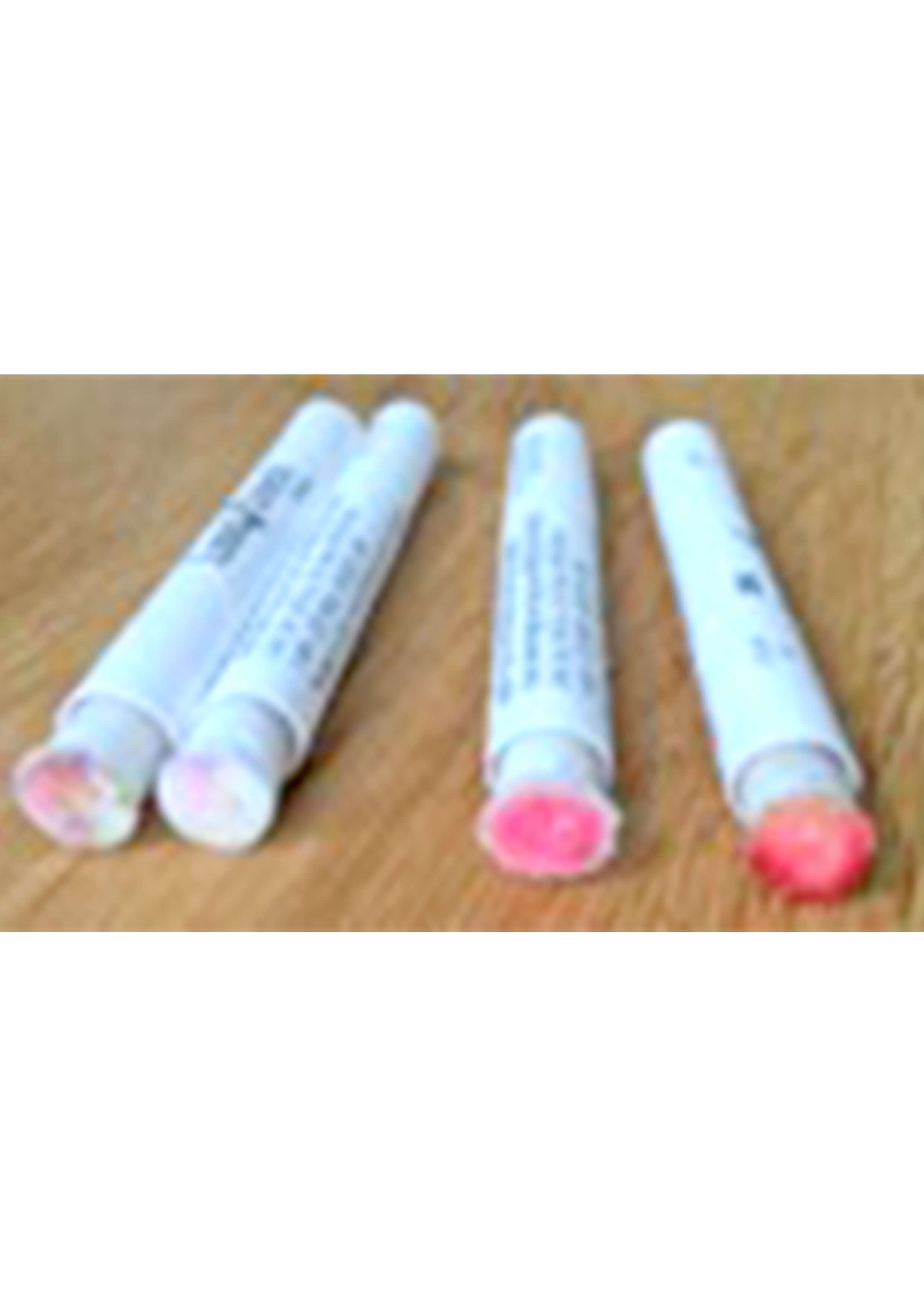
An easy-to-use non-destructive test for detecting solder use.
Drinking water standard for lead
As professionals in the health estate industry, you have a particularly important responsibility to prevent lead from penetrating the potable water systems in your facilities. In the UK the drinking water standard for lead was reduced to 10 μg/l in 2014 and there are plans to reduce this limit further in the proposed revisions to the Drinking Water Directive. This means that some products that allow low levels of lead to dissolve into the water supply may no longer be compliant in the near future. Exposure of consumers to lead in drinking water has reduced dramatically as a result of the water industry’s twin-track approach of chemical treatment (plumbosolvency control) and communication pipe replacement. The communication pipe is the pipe from the main to the boundary of the premises, which is owned by the water company. The pipes and fittings within the premises are the responsibility of the owner. Continuous chemical treatment is not a sustainable solution, however, and lead removal is the only long-term effective measure.
Identify and seek to remove
As there is no safe limit for lead ingestion, those responsible for water supplies in healthcare premises should identify existing lead in their system and seek to remove it. It is absolutely vital that contractors are prevented from using lead in water supply systems and that you look to ensure that nobody uses lead solder on drinking water systems or, better still, carries lead solder in their toolbox at all. Did you know, in fact, that most water suppliers offer to replace their part of the lead supply pipe free when customers replace theirs? This not only removes lead exposure risks, but often has the added benefit of improving water supply flow and pressure too. It is worth checking with your local water company.
Nickel
Nickel is a naturally occurring metal which is most commonly found in water systems due to leaching from pipes or fittings containing the substance. Although its effect on our health can be substantial, it can often be overlooked in sanitary engineering, or by plumbing professionals. The primary source of nickel in drinking water is from leaching of metal alloys that are in contact with the drinking water, such as brass and stainless steel. Of particular concern are nickel-coated fittings such as taps, particularly where the coating is poorly applied and exposed in the spout of a tap, which can leach nickel. Nickel failures can be identified through routine water quality compliance monitoring, where drinking water standards limit nickel to below 20μg /l. The effects of nickel vary, with some individuals being particularly sensitive. This has led to a change in advice by water companies where there are failures. All exceedances are now reported to local Public Health teams, so that they can assess each scenario and tailor advice to the specific circumstance. For example, consumers may be advised to flush taps before drinking or using the water.
Effect on the skin
Nickel can affect the skin and sensitivity, with the most common effect in the population being allergic contact dermatitis. This is the most common symptom reported from the levels of nickel likely to be found in water systems. In one instance a nickel-plated water heater generated very high levels causing nickel intoxication, resulting more severe symptoms such as nausea, vomiting, headaches or weakness – although, cases like this remain rare. In contrast to lead, nickel is actually more likely to be an issue in newer fittings than their older counterparts, particularly when they have been coated with nickel or chromium. Chrome doesn’t adhere straight onto the brass, and a base coating of nickel is used to help bond it to the fitting. It is the areas not covered by the chrome which then dissolve into the water. Nickel is also more likely to be found in higher concentrations when the water has remained static in the system for extended periods, as the metal in the systems has more time to leach into the water. Therefore, good turnover of water is essential in the short term and, where this is not possible, a change to the design or temporary flushing may be required. Research indicates that, over time, the level of nickel leaching will diminish.
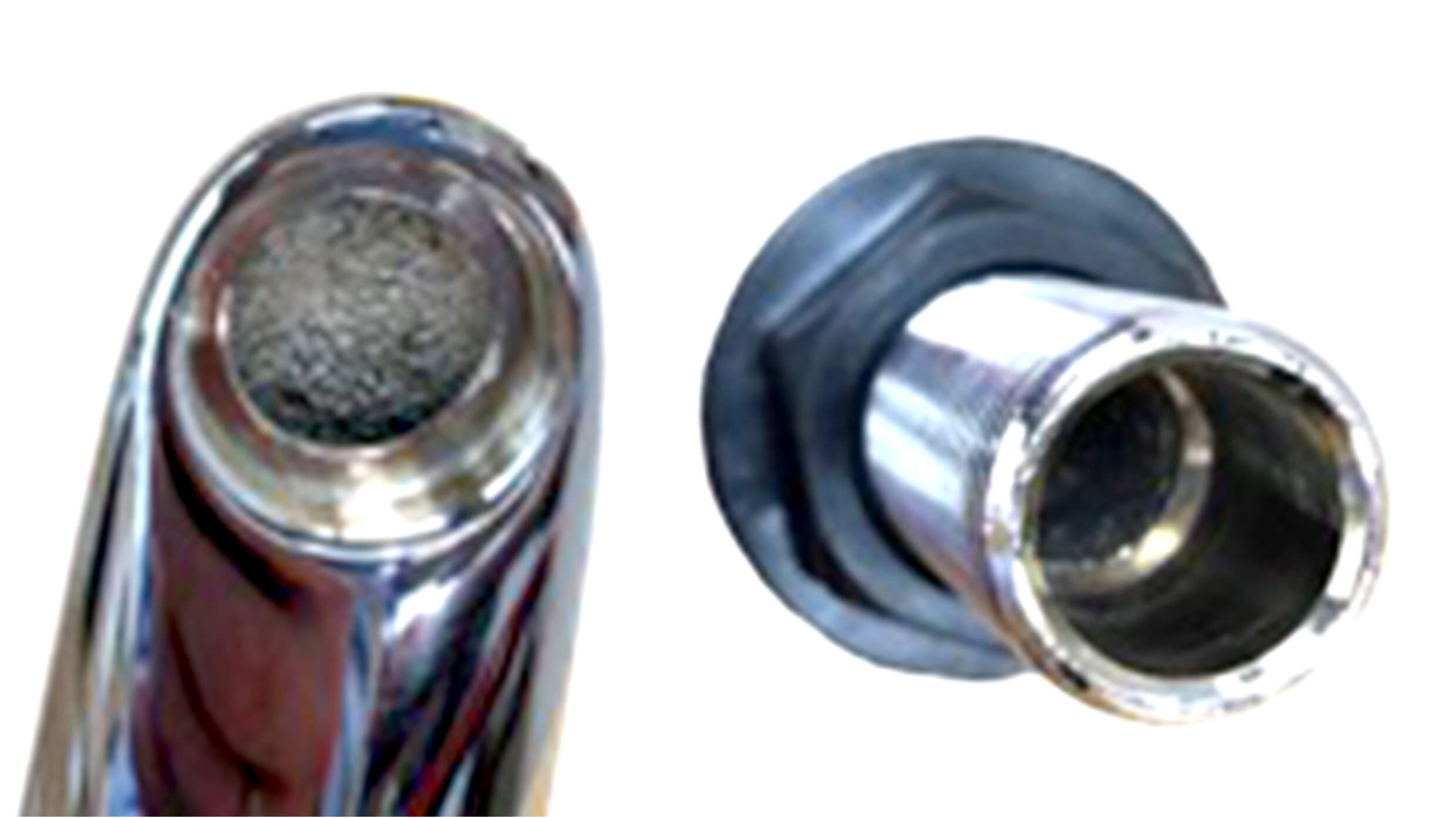
A tap spout and tail connection showing how the plating overspills to the inside water pathways.
Be aware of the signs
While reports of nickel exceedances in water quality sampling remain relatively low, it is worth being aware of the possibility of nickel contamination. If anyone using your facilities is exhibiting or reporting skin sensitivities, allergylike symptoms, or similar, it’s possible that they are being affected by nickel in the water supply. It is much better to be safe and have a test conducted, where the water analysis should reveal if it is present – if it is, consult your local Public Health team for advice.
Choosing products that are lead and nickel free?
WRAS runs a voluntary product and materials approval scheme, which aims to help manufacturers demonstrate, as required by the Water Supply (Water Fittings) Regulations 1999, that water fittings and non-metallic materials are of a suitable quality and standard. WRAS is just one of a number of approval / certification schemes, not to mention test facilities, which manufacturers can use to demonstrate that their products comply with this requirement. The Regulations stipulate that no material in contact with water required to be wholesome poses a contamination risk. Unfortunately, there are no UK testing requirements for metallic materials. This means that approval schemes are not able to include them in their formal requirements. The UK has been participating in the 4MS initiative, which seeks to identify common European standards for materials in contact with wholesome water. A new European Standard, BS EN 15664, has been issued, which establishes a method to assess metal leaching, but it does not include UK acceptance criteria, which prevents it being used to demonstrate conformity with this requirement. There is a suggestion that manufacturers should be encouraged to use metal alloys from the 4MS positive list. WRAS agrees that use of alloys on this list would, in the longer term, improve compliance and reduce the risks to consumers from metals leaching from metallic fittings. However, we remain concerned that until UK performance criteria are set, the use of alloys from this list cannot be required and, as a result, not all manufacturers will use them. We also note that metal leaching rates can increase over the first few months of installation. The long-term metal leaching test for BS EN 15664 will not address this risk or the risk of nickel leaching from surface finishes on water fittings such as nickel plating.
EPDM
EPDM (ethylene propylene diene monomer) is a synthetic rubber material that can be found in many products such as hoses, washers, flexible seals and thermostatic mixing valves (TMVs) – all of which are likely to be found on a healthcare estate. Some forms of EPDM may provide an environment that supports microbial growth. It is not clear why the material is susceptible to microbial colonisation; this could be due to inappropriate materials providing nutrients, among other theories. One school of thought is that it might be attributable to the surface finish, as some EPDMs have been found to have particular rough surfaces which facilitate colonisation. Consequently, NHS Estates & Facilities has raised concerns in an Estates Alert regarding the use of EPDM. As with all forms of non-metallic materials, there are concerns that some materials, including EDPM, can leach nutrients which can further enhance microbial growth. Healthcare premises should always select products that have been tested to demonstrate conformity. While some EDPM products can conform to the non-metallic materials in contact with drinking water testing standard (BS 6920), they may not be considered to perform as well as alternatives such as copper pipe.
Importance of testing and competent installers
It is only when fittings are tested that manufacturers and suppliers can be certain that they meet minimum standards and compliance with water fittings regulations. WRAS provides an exhaustive and up to date list of all products and materials that have been rigorously tested and proven to be safe, robust and efficient, provided they are installed and maintained in the proper manner. The list can be found online at www. wras.co.uk, or you can check individual products for the WRAS Approved logo on the packaging. It is vital that you are sure that any products or materials used on your premises are compliant with the regulations and checking that they have been WRAS Approved is one way of certifying this. This is especially crucial when you are working with the water supplies for healthcare estates, as the requirement for the potable water to be safe and uncontaminated is of upmost priority in a medical environment. If there are any issues or you have any questions, it is always best to get in contact with WRAS or your local water supplier to ensure that your water systems remain safe, secure and efficient.
Appropriate qualifications
Only installers with the appropriate qualifications, regulatory knowledge, and competence should be used to install and maintain water installations. WaterSafe is the national register of approved plumbers in the UK, supported by all the UK water companies and the drinking water quality regulators. Approved plumbers on its register are all trained in the Water Fittings Regulations – the national requirements which govern the design, installation, operation, and maintenance of plumbing systems, water fittings, and appliances, which use water. As well as protecting the quality of drinking water, the Regulations are designed to prevent the ‘waste and undue consumption of water’. For most types of plumbing work, plumbers have a legal duty to notify the local water supplier before they start work, which can lead to delays. Approved plumbers can carry out some work without advanced notification. A ‘work completed’ certificate issued by a WaterSafe plumber also provides a defence if challenged by a water company enforcing the Water Fittings Regulations. In addition to plumbing installers, water companies operate sector memberships for specialist areas of work covering external water services (below ground pipework etc), catering equipment, and point-of-use (chilled water) equipment. You can also search for these sector scheme members on the WaterSafe website.
Conclusion
There are a range of materials that could potentially contaminate the water supply and this is an incredibly important issue for those managing hot and cold water supply systems in healthcare premises, as they have a responsibility to protect patients, visitors and staff. Metals such as lead and nickel leaching into the water supply have known health effects and there are measures which can minimise these risks. The selection of appropriate, compliant products is essential, as is using qualified contractors who understand the Water Fittings Regulations and would never use lead solder.
About Paul Millard
Paul Millard, Technical manager at WRAS, joined WRAS in 2012, and provides technical liaison and support both to the water industry and other external organisations. Previously, he worked for Anglian Water, where he was Water Regulations Manager responsible for the company’s enforcement of Water Fittings Regulations. With over 25 years’ experience in the water industry, his early career saw him involved in a range of activities – including network management, leakage, customer complaints and water byelaws / regulations. Since 2001 his career has had a heavy focus on providing technical expertise and guidance on the enforcement and interpretation of the Water Fittings Regulations – culminating in him becoming increasingly involved with national standards as a water industry representative.




